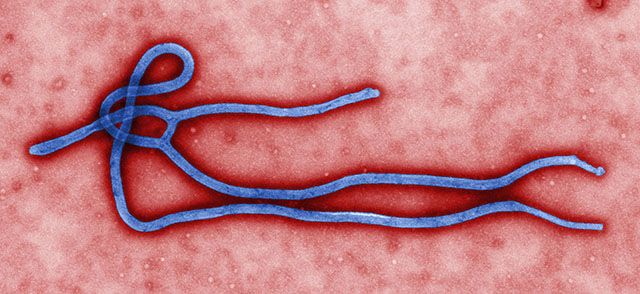What is the Ebola virus?
Ebola was first found in Zaire or what is now known as the Democratic Republic of Congo, in 1976. The Ebola virus is an extremely rare disease and symptoms are similar to a very severe flu. Sweating, body aches, pains, vomiting and uncontrollable diarrhea are all symptoms of Ebola. There is a possibility that Ebola causes hemorrhage of the ears, nose, eyeballs and mouth, but only half of the patients diagnosed with Ebola have hemorrhaging.

“There are five strains of Ebola, four of which have caused the disease in humans: Zaire, Sudan, Taï Forest, and Bundibugyo. The fifth, Reston, has infected nonhuman primates only,” according to Vox. “Though scientists haven’t been able to confirm this, the animal host of Ebola is widely believed to be the fruit bat, and the virus only seldomly makes the leap into humans.”
The symptoms, however, do not show until days after interaction with someone with Ebola.
According to Vox, an Ebola patient describes the symptoms as, “I couldn’t move from the bed. I couldn’t talk. I couldn’t do anything. I lost 25 pounds. I was in the hospital for one month until they discharged me.”
Can I get Ebola?
In total, there have been eight cases in the United States. The death of Thomas Eric Duncan, 42, a Liberian man, on Wednesday, Oct. 8, who was at the center of a widening public health scare, really frightened Americans. There has been one death, three recoveries and four in isolation and treatment as we speak. Ebola is an extremely difficult disease to contract because it requires direct contact with the bodily fluids of someone with the disease.
Unless you have been around the eight cases of Ebola within the country during the time they had symptoms or you traveled to or from West Africa, there would be no way that you would get Ebola.
If you do show signs of Ebola or have been around someone who has been tested positive, you should seek immediate help.
How contagious is it?
Ebola is a very rare disease but it also has been in news often because of the outbreak all across West Africa and it has now gotten to the U.S. But contracting this disease is not possible unless you are around people who have been tested positive with it or have traveled to West Africa.
“The virus has been able to live in semen for up to 82 days after a patient became symptomatic, which means sexual transmission – even with someone who has survived the disease for months – is possible,” according to Vox.
Since Oct. 9, there have been 2,455 cases in Sierra Leone, 1,044 cases in Guinea, 941 cases in Liberia, meaning that as of today there are over 3,000 people in the world with this deadly disease and every day that number is growing.
How many people will get it?
The death toll is already at 4,000 and roughly 8,000 people have been infected as of October 2014.
Half of the patients that are diagnosed with Ebola, die.
“Assuming the worst is true, the Centers for Disease Control and Prevention has a much bigger projection for this epidemic: up to 1.4 million people infected by January,” according to Vox. “Outside of Africa, the risk is relatively high in the UK and France, but thankfully very low in India and China. The more advanced health-care systems in the UK and France are much better equipped to deal with an Ebola outbreak, while less advanced systems in China and particularly India, which also have considerably bigger populations to manage, could struggle to deal with an epidemic.”
What economic impact will it have on the United States?
There has already been an impact and there are only eight cases in the U.S.
The Center for Disease Control and Prevention’s emergency preparedness budget fell since 2006 to about half and the Public Health Emergency Preparedness Cooperative Agreement Funding is one of the federal government’s main ways of helping local areas prepare for unexpected outbreaks.
“Funding for it has steadily fallen in recent years after a slight increase in 2006. Emergency preparedness is an easy budget to cut when there are not any emergencies happening, according to Vox. “But the decision has consequences: we’re learning with the current outbreak that our public health systems – both in the U.S., and globally – simply are not prepared to handle an outbreak of a dangerous disease like Ebola”
When the outbreak started, there was no process in play, no set process of how everything would work out. So in September 2014, “the drug company GlaxoSmithKline announced it took the unprecedented step of starting mass production on an Ebola vaccine that has just begun being tested in humans.”
Because of this, the usual drug approval processes were “condensed and potentially skipped.”
Of the three people who have taken the antibody therapy drug, ZMapp, two have survived and one has died. However, there is a 50 percent chance that when you are diagnosed with Ebola, you survive.
But the real question to be asking is will the lack of healthcare for Americans weigh heavily on the shoulders of the sick?
Where will it go next?
There is a process called “contact tracing,” which means that Ebola patients are put into isolation but then officials outline and investigate movements of the patient prior to getting the symptoms and becoming contagious. Then officials build “concentric circles,” which are people that the patient would have come into close contact with are also observed for 21 days.
According to Vox, in Africa the trade industry goes into parts of China and India and if it gets into those countries, there could be serious consequences.



